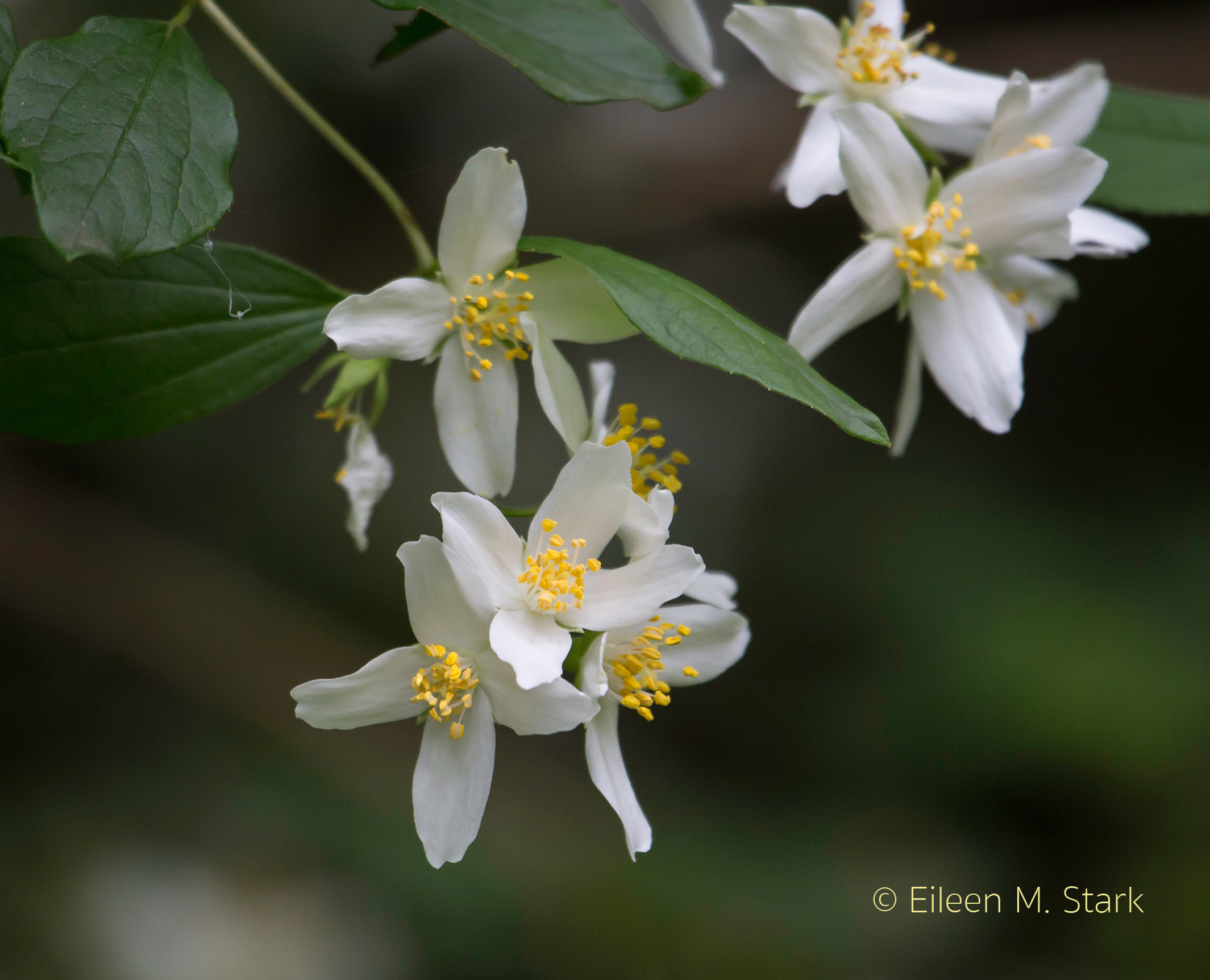
Had Carl Sandburg penned a poem about the way a captivating scent wafts through the air — prior to his famous “Fog” — he might have written that it approaches us “on little cat feet.” Like fog, scent is silent and invisible and adds a fresh, sensual dimension to a garden (or a walk in the woods for that matter). One of the most fragrant flowering shrubs is mock orange, and the Pacific Northwest’s native offering, Philadelphus lewisii (Western mock orange or Lewis’ mock orange), doesn’t disappoint. Plan ahead and place this medium-sized deciduous shrub where its fragrance can be noticed.
Philadelphus lewisii is named after scientist and explorer Meriwether Lewis, who collected it in 1806 during the Lewis and Clark expedition. Native Americans had numerous uses for it, including making tools, snowshoes, furniture, and even soap.
How it grows
Although there is quite a bit of individual variation within this species, the structure and growth pattern of this particular shrub goes something like this: Maturing at 5 to 10 feet tall and nearly as wide, this fairly fast grower may send out arching basal shoots as it ages, and eventually become a thicket. In late spring, flowering shoots appear, followed by vegetative growth. Rich green, egg-shaped leaves (roughly three inches long) grow in pairs along its stems. At the tips of branches, multiple clusters of white, four-petalled blossoms adorned with soft yellow stamens emerge in late spring or early summer and sparkle against a green, leafy backdrop. Flowers measure one to two inches in diameter, and offer a lovely, fruity fragrance.
Wildlife value
Mock orange’s fragrance doesn’t just appeal to us, though—it attracts nocturnal moths and butterflies like the western tiger swallowtail. As they feed on its nectar and incidentally brush against the flower’s anthers, thousands of male pollen particles are released, pollinating its flowers. Other pollinators attracted to scent include bees, but also syrphid flies (aka flower flies), which are particularly fond of white and yellow flowers. In late summer into winter, mock orange’s wildlife appeal continues as the plant’s tiny seeds are consumed by many species of birds, including goldfinches, as well as squirrels. It also provides twiggy cover year round.
flower’s anthers, thousands of male pollen particles are released, pollinating its flowers. Other pollinators attracted to scent include bees, but also syrphid flies (aka flower flies), which are particularly fond of white and yellow flowers. In late summer into winter, mock orange’s wildlife appeal continues as the plant’s tiny seeds are consumed by many species of birds, including goldfinches, as well as squirrels. It also provides twiggy cover year round.
Try it at home
Mock orange is easy to grow. It tolerates both drought (after it’s established, of course) and moisture, and will do well in full to part sun or in a fair amount of shade (but not deep, dark shade). It’s also a good shrub for stabilizing soil on slopes due to a fibrous root system. While it’s not fussy about soil, if your soil’s in bad shape consider incorporating and/or mulching with some decomposed organic matter (like compost) to get it off to a good start.
It’s best to let native plants attain their natural size and habit, but if yours was placed too close to a path or some such, pruning may be necessary. Mock orange should only be pruned soon after flowering since next year’s blossoms develop on the previous year’s growth.

Grab a partner
Though not common, western mock orange is widespread. It occurs naturally from southern B.C. to northern California and the Sierras, and east to Alberta and western Montana, at low to mid-elevations. Growing along creeks and seeps and forest edges, on hillsides, and within chaparral and pine and fir communities, it associates with species such as Douglas-fir, oceanspray, ninebark, osoberry, baldhip rose, tall Oregon grape, and others. If space allows, try it as a member of a multi-species (unclipped) hedgerow (should pruning be necessary, do it soon after flowering, so that the following year’s blossoms aren’t affected). To stimulate flowering on older shrubs, cut back flowered growth to strong young shoots, cutting out up to 20 percent of aging stems near their base.
Other fragrant PNW plants include wallflower (Erysimum capitatum), Nootka rose (Rosa nutkana), clustered rose (Rosa pisocarpa), bald hip rose (Rosa gymnocarpa), Oregon grape (Mahonia spp.), fringecup (Tellima grandiflora), serviceberry (Amelanchier alnifolia), checker mallow (Sidalcea spp.), oceanspray (Holodiscus discolor), some ceanothus (Ceanothus spp.), bear grass (Xerophyllum tenax), milkweed (Asclepias spp.), madrone (Arbutus menziesii), and black hawthorn (Crataegus douglasii). Enjoy!